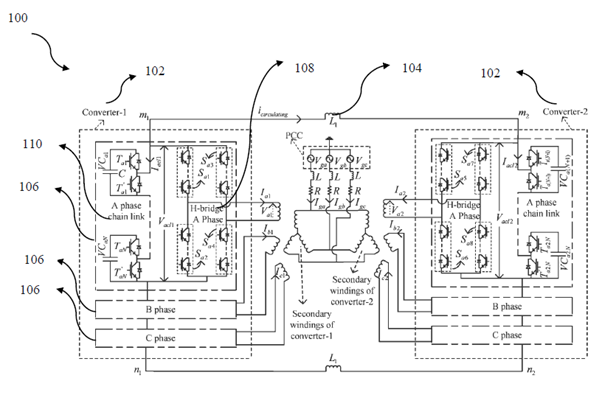This invention provides a Dual Hybrid Multilevel Converter (DHMC). The DHMC comprises a plurality of converters configured to feed a grid in the DHMC. DC side chain-links of each converter of the plurality of converters is inter-connected through one or more inter-connecting inductors. Each converter of the plurality of converters is associated with at least three phase-links and single phase-link of each converter comprises of an H-bridge and one or more chain-links. The DHMC further comprises at least three single phase transformers configured to receive output from each converter for generating output voltage of the DHMC.
The increasing penetration of non-linear unbalanced loads and energy sources into the grid, such as industrial loads and renewable energy sources, the power quality of the power system is continuously degrading. Reactive power support from different sources and converters such as Static Compensators (STATCOMS) can solve the power quality problems.
The Parallel Hybrid Modular Multilevel Converter (PHMMC) used for HVDC applications has less sub-modules, switching devices compared to Modular Multilevel Converters (MMC). However, it is characterized to operate at a fixed modulation index. To control the flow of reactive power between the converter and grid, the output voltage of the PHMMC needs to be regulated and this is possible only if the modulation index of the converter is controllable. The ability to regulate the modulation index of PHMMC is achieved through Third Harmonic Voltage Injection Method (THIM). By injecting same quantity of third harmonic voltage component in all the three chain-links of the PHMMC, control over the modulation index is attained but the range of control over the modulation index still remains limited. During unbalanced conditions, the capacitor voltage of the chain-links tend to divert from their reference values due to uneven exchange of power from the chain-links with the grid. The capacitor voltages are restored back to their reference value by injecting unequal quantities of third harmonic voltage in the three chain-links. The disadvantage is that the injected unequal third harmonic components may appear in the line-line voltage of the grid thus injecting harmonics into grid. Also, with the injection of the unequal third harmonic voltage, the PHMMC can handle limited degree of unbalance in the grid voltage as presented in literature.
The DHMC contains two converters (converter-1 and converter-2) wherein converter-1 and converter-2 are configured to exchange reactive power with the grid independently or parallelly, wherein the converter-1 and converter-2 are connected in a front to front fashion (coupled at their ac sides through the transformers) and also in a back to back fashion (the dc sides of converter-1 and converter-2 are also interconnected.
The proposed DHMC has the ability to operate in the full range of available modulation index without any additional third harmonic injection methods. During unbalanced grid conditions, the capacitor voltages of the proposed DHMC can be maintained at their reference value by injecting common mode voltage in the chain-links. Since, the same common mode voltage is injected in all the chain-links, it doesn’t appear in the grid. The capacitor voltages can also be controlled by regulating the circulating current flowing in the inter-connecting inductors. The energy storage requirement to generate an output of one MVA is 7.94 kJ, under balanced grid conditions, which is very less compared to existing multilevel configurations. The size of the capacitance, number of energy storing devices and number of switching devices required are also less compared to Delta Cascade H-bridge and Modular multilevel converters. The proposed converter contains switching devices that switch at fundamental frequency and operate in Zero Voltage Switching mode (ZVS) thereby reducing the switching loss.
A prototype has been developed.
- The proposed innovation has been validated with simulations and theoretical analysis
- Experimental results need to be analyzed to validate the operating principles
This technology occupies less footprint and offers less cost. Hence, it is likely to consume less funds from the government (save tax payers money) in the installment process. It also improves power quality of the grid and hence, prevents emergency loads (such as medical equipment, military equipment).
- This technology is very much suitable for FACTS and high/medium voltage power system applications.
- It is also useful for high voltage and medium voltage applications, simple, easy to adopt, modular construction, energy storage required to generate an output of one MVA is less, lesser number of capacitors, lower capacitor size, lower switching losses, Zero Voltage Switching (ZVS soft switching) capability, can be applied to compensate unbalance in grid/load.
Geography of IP
Type of IP
202021004129
518485

